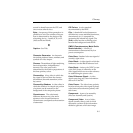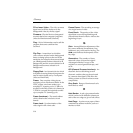
G-5
Glossary
EEPROM (Electrically Erasable
Programmable Read Only Memory):
An information storage device on which
the information cannot readily be
changed. It is nonvolatile memory in that
power conditions do not effect the
information. (Also see PROM, ROM, and
RAM.)
Effects Dissolve: A microprocessor-
controlled mode in which the analog
values (control settings) of one effects
setup change smoothly over a
predetermined time to those of another
effects setup.
E-MEM® (Effects Memory): A GVG
effects-memory system capable of storing
and recalling switch and control settings
of switcher effects configurations.
Encoded Chroma Key: A chroma key
which uses an encoded video signal (e.g.,
from a VTR) instead of separate RGB or Y,
CR, CB signals for deriving the key.
Encoded Video: A video signal which
contains both luminance and chrominance
information in the same signal. (Also see
Composite Video, NTSC, and PAL.)
Encoder: A device used to create a single
composite color signal from a set of
component signals. Commonly used on
switcher Program and Preview outputs for
composite monitor requirements.
Error Message: A message generated
by the program to identify a program error
or the area in which a malfunction occurs.
Event Number: Number assigned by the
editing system to each performed edit.
Exception Processing: The activity of
a CPU in response to an interrupt in its
normal execution of instructions.
Execution: The carrying out of a
particular set of instructions.
External Key: An input signal to the
switcher used exclusively as a key source.
Typically this key source is selected
automatically with the selection of the key
fill.
Extrude: A title enhancement in which a
depth dimension is added to the title key
signal.
F
Fade-to-Black: See Preset Black
Transition.
Fault Isolation: The determination of
the cause of a failure by identifying a
defective component or circuit.
Field: One complete scan of the TV
screen by the electron beam. In the NTSC
standard, two interleaved fields of 262 and
263 raster lines make up a frame. In the
PAL standard, two interleaved fields of
312 and 313 raster lines make up a frame.
The duration of a field is approximately 1/
60 of a second in NTSC or 1/50 of a second
in PAL (625 lines).
File: A collection of related records in a
computer system treated as a unit.


















